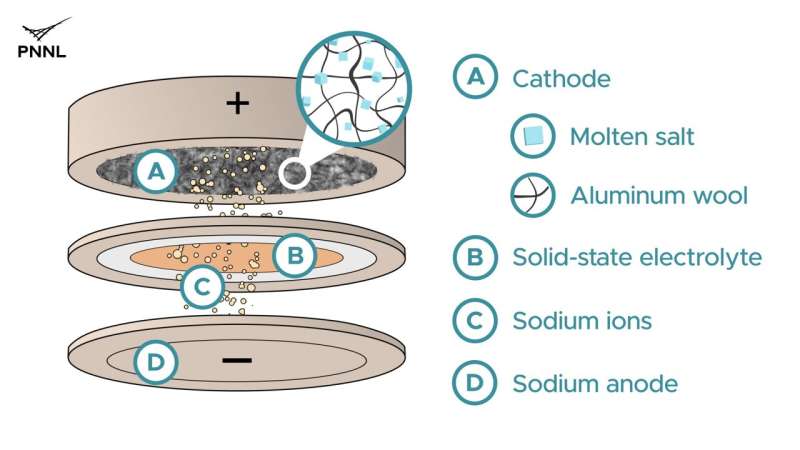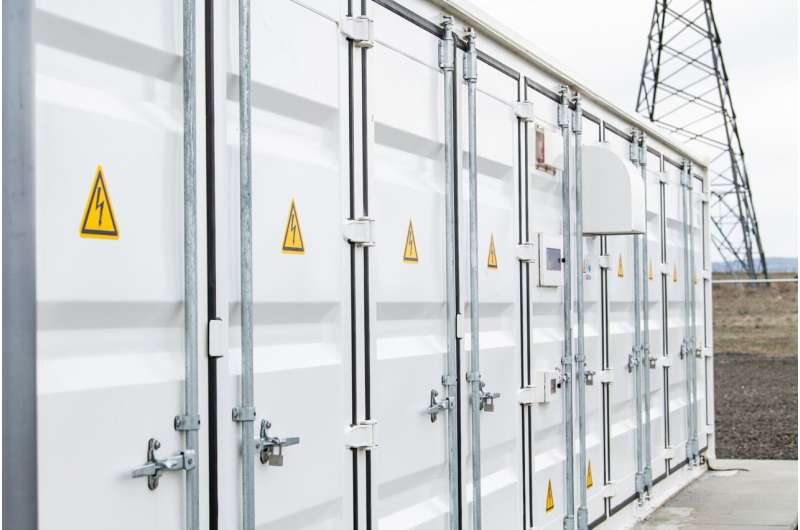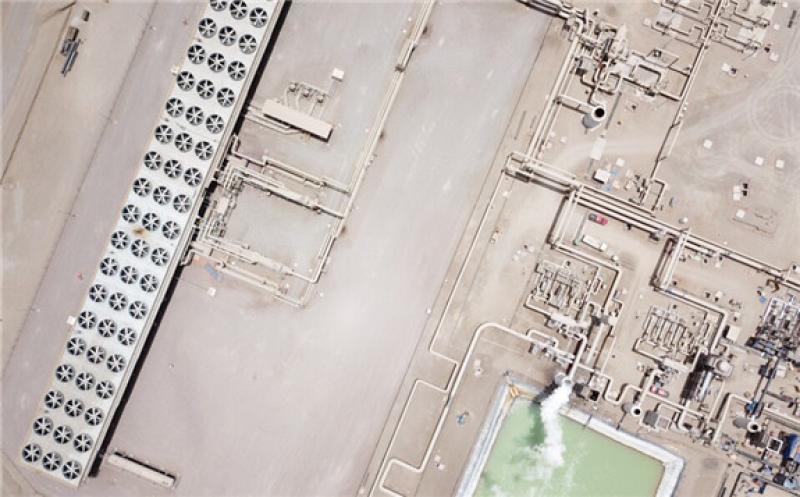"We showed that this new molten salt battery design has the potential to charge and discharge much faster than other conventional high-temperature sodium batteries, operate at a lower temperature, and maintain an excellent energy storage capacity," said Guosheng Li, a materials scientist at PNNL and the principal investigator of the research. "We are getting similar performance with this new sodium-based chemistry at over 100 °C [212 °F] lower temperatures than commercially available high-temperature sodium battery technologies, while using a more Earth-abundant material."
More energy storage delivered
Imre Gyuk, director of DOE's Office of Electricity, Energy Storage Program, which supported this research, noted, "This battery technology, which is built with low-cost domestically available materials brings us one step closer toward meeting our nation's clean energy goals."
The new sodium-based molten salt battery uses two distinct reactions. The team previously reported a neutral molten salt reaction. The new discovery shows that this neutral molten salt can undergo a further reaction into an acidic molten salt. Crucially, this second acidic reaction mechanism increases the battery's capacity. Specifically, after 345 charge/discharge cycles at high current, this acidic reaction mechanism retained 82.8 percent of peak charge capacity.
The energy that a battery can deliver in the discharge process is called its specific energy density, which is expressed as "watt hour per kilogram" (Wh/kg). Although the battery is in early-stage or "coin cell" testing, the researchers speculate that it could result in a practical energy density of up to 100 Wh/kg. In comparison, the energy density for lithium-ion batteries used in commercial electronics and electric vehicles is around 170–250 Wh/kg. However, the new sodium-aluminum battery design has the advantage of being inexpensive and easy to produce in the United States from much more abundant materials.
"With optimization, we expect the specific energy density and the life cycle could reach even higher and longer," added Li.

Sodium battery shows its mettle
Indeed, PNNL scientists collaborated with colleagues at the U.S.-based renewable energy pioneer Nexceris to assemble and test the battery. Nexceris, through their new business Adena Power, supplied their patented solid-state, sodium-based electrolyte to PNNL to test the battery's performance. This crucial battery component allows the sodium ions to travel from the negative (anode) to the positive (cathode) side of the battery as it charges.
"Our primary goal for this technology is to enable low-cost, daily shifting of solar energy into the electrical grid over a 10- to 24-hour period," said Vince Sprenkle, a PNNL battery technology expert with more than 30 patented designs for energy storage systems and associated technology. "This is a sweet spot where we can start to think about integrating higher levels of renewables into the electrical grid to provide true grid resiliency from renewable resources such as wind and solar power."
Sprenkle was part of the team that developed this battery's new flexible design, which also shifted the battery from a traditional tubular shape to a flat, scalable one that can more easily be stacked and expanded as the technology develops from coin-sized batteries to a larger grid-scale demonstration size.
More importantly, this flat cell design allows the cell capacity to be increased by simply using a thicker cathode, which the researchers leveraged in this work to demonstrate a triple capacity cell with sustained discharge of 28.2-hours under laboratory conditions.
Most current battery technologies, including lithium-ion batteries, are well suited for short-term energy storage. To meet the demand for 10-plus hours of energy storage will require the development of new, low-cost, safe, and long duration battery concepts beyond current state-of-the-art battery technologies. This research provides a promising lab-scale demonstration toward that goal.

The ability to store energy generated by renewable energy and release it on demand to the electrical grid has driven rapid advances in battery technology, with many new designs competing for attention and customers. Each new variation must satisfy the demands of its own niche use. Some batteries, such as those having PNNL's freeze-thaw battery design, are capable of storing energy generated seasonally for months at a time.
Compared with a seasonal battery, this new design is especially adept at short- to medium-term grid energy storage over 12 to 24 hours. It is a variation of what's called a sodium-metal halide battery. A similar design employing a nickel cathode as part of the system has been shown effective at commercial scale and is already commercially available.
"We have eliminated the need for nickel, a relatively scarce and expensive element, without sacrificing battery performance," said Li. "Another advantage of using aluminum over nickel is that the aluminum cathode charges more quickly, which is crucial to enable the longer discharge duration demonstrated in this work."
With this milestone reached, the team is focusing on further improvements to increase the discharge duration, which could greatly improve grid flexibility for greater incorporation of renewable power sources.
And because it operates at a lower temperature, it can be manufactured with inexpensive battery materials, instead of requiring more complex and expensive components and processes as in conventional high-temperature sodium batteries, said David Reed, a PNNL battery expert and study co-author.
More grid energy storage at lower cost
In 2023, the state-of-the-art for grid energy storage using lithium-ion batteries is about four hours of energy storage capacity, said Sprenkle. "This new system could significantly increase the amount of stored energy capacity if we can reach the expected cost targets for materials and manufacturing," he added.
As part of the study, the researchers estimated that a sodium-aluminum battery design based on inexpensive raw materials could cost just $7.02 per kWh for the active materials. Through optimization and increasing the practical energy density, they project that this cost could be lowered even further. This promising low-cost, grid-scale storage technology could enable intermittent renewables like wind and solar power to contribute more dynamically to the nation's electrical grid.
Neil Kidner, a study co-author and president of Adena Power, a sodium solid-state battery manufacturer, is collaborating with PNNL to advance sodium-based battery technology. "This research demonstrates that our sodium electrolyte works not only with our patented technology but also with a sodium-aluminum battery design," he said. "We look forward to continuing our partnership with the PNNL research team towards advancing sodium battery technology."




